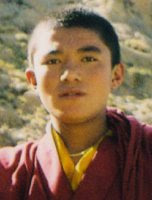Agam's Gecko


Sunday, June 01, 2008
ANOTHER SHOOTING REPORTED IN TIBET, WHERE ONE'S CONSCIENCE IS WORTH ONE'S LIFE
| T |
he fearless Buddhist nuns of Kardze County, Kham (Ch: Sichuan) have been continuing to challenge the authorities, willing to exchange a few minutes of freely expressing their aspirations, for the self-sacrifice of certain arrest, near-certain beatings and other abuse, and sometimes worse.
On the morning of May 28, three nuns of Drakkar Nunnery mounted a peaceful demonstration in the county's central market. They shouted freedom slogans, called for Dalai Lama's swift return to Tibet, and demanded the immediate release of all political prisoners. They also distributed pamphlets calling for Tibetan independence.
It will be recalled that several nuns of Drakkar had held a similar action in the same location in April, throwing hundreds of pieces of paper containing these same aspirations, before being arrested. Then on May 11 or 12, fourteen more nuns protested the earlier detentions in the centre of Kardze town. They were brutally beaten up before being taken away, leaving bloodstained pavement where security forces had bashed the head of at least one of them, named Taga, who bled profusely as she was taken away.
In the May 28 incident, Ven. Sangye Lhamo, 26, Ven. Tsewang Kando, 38, and Ven. Yeshi Lhadon, 24, were apprehended and taken to an unknown location in an unknown condition. All are from Kardze County. About an hour afterwards, a solo protest was mounted by Rigden Lhamo, 21, a female student of the Tapontsang family (some readers may know of Ama Adhe Tapontsang, the Voice that Remembers). Rigden Lhamo unfurled the Tibetan national flag and shouted freedom slogans at the Kardze County government headquarters.
Gunshots rang out, according to witnesses. There is no clear information as to who the security forces were shooting at, or who they might have hit. Rigden Lhamo was taken away and witnesses saw blood on her body, but it can't be determined whether this was from the shooting or from the severe beating she also suffered. It is confirmed that she was injured in some manner and should have had medical attention. It is not known if she received any, nor where she is being held.
The Tibetan Administration in exile confirms the incident, adding the information that local people on the scene had been telling the Public Security Bureau officers who carried out the suppression that their actions were not good. The PSB of course paid them no heed.
CTA also reports on May 30 that another prisoner has been tortured to death. Paltsel Kyab, aged 58, lived in the Nak-tsangma area in Ngaba County (Ch: Sichuan), and was arrested on April 24 by PSB officers under suspicion of protesting in March. He died in Ngaba County prison on May 24 following severe torture. By my count, this brings the known death toll to 208 (the death of an elderly man, Kunga, following his release from torture in detention, was reported last week as the 207th).
Tibetan Solidarity Committee reports further on the family of Nechung, a Tibetan lady who was held for just nine days in March, released in a very serious physical condition, was refused medical attention, and finally died on April 17 (see here). She had four children of her own, her husband was still on the run at that time, and now it's reported that he has older children as well -- two of whom were arrested soon after Nechung's death. The elder son, Takho, was severely injured when Chinese security forces broke both his legs. Unlike Nechung, he was allowed hospital care. Both Takho and his younger brother Choepe had been badly beaten, although Choepe's condition isn't known.
Also reported in the TSC May 27 bulletin, a large reward was offered by the authorities for information leading to the capture of three wanted Tibetans, Rigdak, Menkyab and Goeso, all local businessmen in Serthar County, Kardze who were all known to be helpful to local people. Authorities were said to have issued a death sentence if the three failed to surrender. One of them was captured (unclear if he surrendered), and his whereabouts are unknown.
The "patriotic" re-education campaign continues to be widely implemented in Tibetan areas, both inside and outside the "Tibetan Autonomous Region." A major part of this "teaching" is apparently the wanton destruction of items which symbolize the propaganda's depiction of Tibet's "dark, feudal society," as well as the theft of anything valuable. Faithful readers will have seen photos of the destruction of sacred portraits at Kirti Monastery in Ngaba Prefecture, which has borne the brunt of many brutal raids since March. But that's not all:
Following the successive raids conducted by the Chinese armed forces since March 28 in Kirti Monastery in Ngaba (Ch: Aba) in more than 700 monk quarters, it is estimated that commodities worth more than 1.2 millions of Renminbi (Chinese currency) have either been confiscated or looted by the security forces, apart from the immense damage caused to the religious texts including volumes of Kagyur and Tengyur (scriptures) and many ancient artifacts of the monastery.Radio Free Asia has reported that Buddhist monks have been arrested for alleged "terrorist bombings" in Markham County, Chamdo Prefecture, in the TAR. Several similar arrests had been announced by Chinese state-run media in mid-April, for a bomb that was said to have exploded on March 23 (giving little information on its location). There was no explanation why it took so long for the report of that bomb to be made public, which came only with the arrests. There has been no independent confirmation of that alleged explosion.
In the more recent case, five monks from Gonsar Monastery in Markham were arrested on May 24 in connection with some small explosions which occurred around April 6 - 7.
"There were four small explosions in the Markham area, but nobody knows who did it," the source said.An official at Markham PSB said he was not allowed to comment. A number of other monks and laypeople had earlier been arrested in Markham County, in the few days following a resisted attempt to "re-educate" at two monsteries in Garthog township. The monks had refused to write denunciations or sign the prepared documents. Tibetan citizen journalist had confirmed those arrests at the time, adding that the prisoners had been paraded through the town on a truck with black sacks pulled over their heads.
"The authorities are linking the explosions to the patriotic campaign"launched around the time of widespread anti-Chinese protests from mid-March, the source said.
According to the source, Ven. Khenrab Tharchin, a member of so-called Democratic Management Committee (DMC) of Shelkar Choedhe Monastery stood up while the campaign was in session by openly opposing the "patriotic re-education" and even told the visiting "work team" that he cannot denounce the Dalai Lama as required under the campaign. Another eleven monks of the same monastery stood up in support of Ven. Khenrab Tharchin and adamantly opposed the campaign in unison. According to source, after the incident, entry to the monastery was closed for faithful devotees and visitors. Monks were ordered [prevented] from leaving their monastery compound and even cell phones were known to have been confiscated to curb the report of the incident from leaking to the outside world and the monks were even known to have been threaten[ed] with dire consequences if found 'leaking' the information to the outside world.Tingri County has just seen the back end of her flaming harmoniousness, for this area is the Tibetan approach to Mount Chomolangma (Everest). She must have forgotten to drop off a little of that harmony as she passed through.
Following the "work team's" failure, later the same night scores of Chinese PAP and PSB forces raided the monastery and took away the twelve resisting monks from their residences. Their condition and the place they were taken is not known. A full name list, and some of their photographs, are given at the linked page. Family members who inquired about them were intimidated by the PSB officers and warned not to damage the image of the government.
These campaigns are not only applied to monasteries, but also target government employees, security forces, farmers, nomads, entrepreneurs and even (or especially?) school children. They certainly belie the claim of China's own constitution to protect freedom of religious belief. In fact, nothing interferes with this freedom of belief more than the CCP government. The officially atheist Party takes upon itself the right to tell people what they will or will not believe, and enforces this with state violence. This Party, says the Tibet "Autonomous" Region's Chinese ruler Zhang Qingli, is the rightful Buddha for Tibetans. The Party seems not to have a clue as to how this plays out among the people.
"It could be that they [the protestors, particularly referring to the monks] could not take oppression any more. The fact that the Chinese are forcing Tibetans to denounce His Holiness the Dalai Lama everyday makes Tibetans put their lives on the line and protest."The same person described a letter left behind by a nun before she went to protest in Kardze. It almost reads like a suicide note:
"I cannot bear any longer the constant denunciation campaign against His Holiness the Dalai Lama. I cannot even concentrate on my prayers. I have 500 Yuan [US$72] - give away 50 to others and keep the rest for prayer after I die."Quoting a Tibetan language newspaper, Bod Kyi Bang Chen (the Tibet Express) published May 28, ICT reports that the raising of the red flag over nunneries has also been a sore point in the Kardze protests.
"Security personnel have ordered nuns to hoist a Chinese flag atop the nunnery; they have asked nuns to reveal the instigators and say that they are grateful of the Chinese government. Also, they always ask nuns to denounce His Holiness the Dalai Lama. In return, nuns have told officials that they cannot say that they are grateful of the Chinese government because for five years when nuns were not able to get enough financial backing to rebuild the nunnery, the government did not extend any help for their difficulty. As for the protests [in March], [they said] no one instigated any one, they all took part voluntarily." (Translation from Tibetan, the Tibet Express, Bod Kyi Bang Chen, May 28, 2008).ICT notes that Kardze County has had more political prisoners than any other county outside the TAR. "Patriotic" re-education campaigns had actually been stepped up in that area before the recent round of protests. We haven't heard much detail about what happened in Kardze during the early days of the uprising but an eyewitness has told some of it to the same Tibetan language newspaper.
On March 18 there was a demonstration in Kardze town by ten monks, three nuns, and a young man named Sergah.
"The protest had just happened when I reached the market, and Chinese police were disposing of small pieces of paper that were scattered everywhere. I did not see what was written on the paper, but others told me that the words on the paper read: 'His Holiness the Dalai Lama must be welcomed back to Tibet soon.' Police had sealed off the area, but blood stains were still visible on the street. They say it belonged to the young man, Sergah. The three nuns and Sergah were beaten to the point where they couldn't move and than thrown on to a truck as if they were bags of luggage - it is difficult to tell whether they were alive nor not. In the crackdown, police kicked the heads of monks and other protestors [who were on the ground] and plastic bags were shoved in their mouths to gag them."Readers will surely recall the story of the elderly head of Rong Gonchen Monastery (also called by Rongwu or Rongpo), Alak Kasutsang (Alak Khaso Rinpoche). He had tried to mediate between security forces and demonstrating monks during a peaceful protest at Rebkong County market on April 17, when the security forces cracked down hard. The elderly man was seriously injured and hospitalized. Among his injuries were a broken leg, but CTA reports that this injury has recovered well.
Yet he is once again in critical condition due to his other internal injuries. The monks of the monastery continue to resist their re-education, while some still remain in Chinese custody. It should also be recalled that Alak Khaso Rinpoche had donated 10,000 yuan for Sichuan earthquake victims, and the monks of Rong Gonchen have raised another 50,000 yuan.
The Tibetan Administration also reports that three monks from Lhasa's Ramoche Temple were arrested for having contact with foreigners. They are accused of sharing information with the outside world, and had earlier been arrested with many other Ramoche monks on April 7. All but five of that group were released after 17 days. The three suspected of foreign contact were targeted for re-arrest twice after that, but all the other monks stood in their support and authorities were reluctant to spark another incident. The three were finally apprehended on May 26.
Due to heavy restrictions imposed upon them, the monks of Se Monastery in Ngaba County (Ch: Sichuan) have left their insitution en masse because their situation was intolerable. Several other monasteries have similarly been reportedly emptied for the same reasons, leaving the surrounding residents with no religious practitioners to turn to.
A similar situation has taken place at Taktsang Lhamo Kirti monastery in Dzoge County, also in Ngaba Prefecture. Around 190 of its monks have been barred from participating in religious observances due to their opposition to getting "re-educated." The monks who have not been so barred from carrying out their activities have none the less halted prayer sessions in solidarity with the others.
The Kirti Monastery monks have also been concerned for the well being of those previously arrested and held in Chinese prisons, particularly after the Sichuan earthquake. One of these prisons, in Lunggu County (Ch: Wenchuan), is known to have collapsed. Upon making inquiries, the monks were told that their brothers had not been held there, but were in Sungchu County prison. Upon inquiring there, officials told them the monks weren't there either.
No one seems to know where the jailed monks were being held. Guilty of no crime other than holding to their conscience, they shouldn't have been in a prison in the first place.
.











 Our way of saying "thanks" in the Thai way. Here a nak muay Thai (kickboxer) offers respect and thanks for his teacher (wai khru) before a match. This is our local variation on the ubiquitous "hat tip" used in general blog culture.
Our way of saying "thanks" in the Thai way. Here a nak muay Thai (kickboxer) offers respect and thanks for his teacher (wai khru) before a match. This is our local variation on the ubiquitous "hat tip" used in general blog culture.







